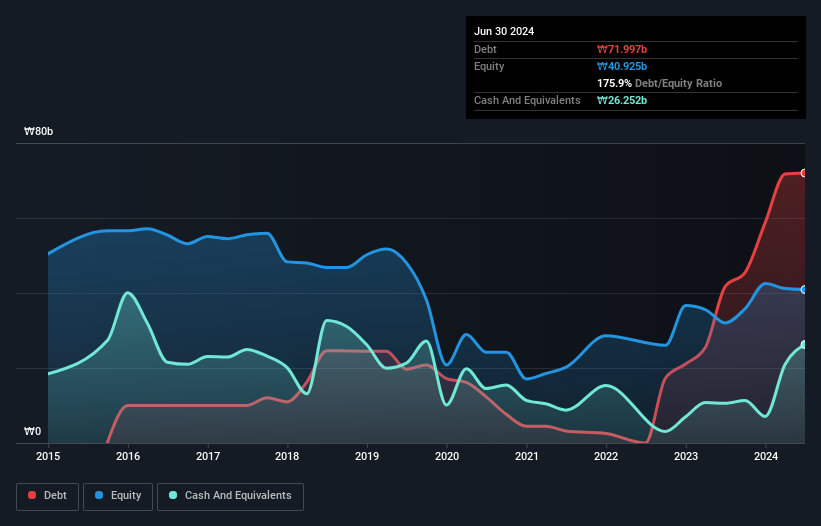- South Korea
- /
- Machinery
- /
- KOSDAQ:A114190
Here's Why KANGWON ENERGY (KOSDAQ:114190) Can Manage Its Debt Responsibly
David Iben put it well when he said, 'Volatility is not a risk we care about. What we care about is avoiding the permanent loss of capital.' So it seems the smart money knows that debt - which is usually involved in bankruptcies - is a very important factor, when you assess how risky a company is. We can see that KANGWON ENERGY Co., Ltd. (KOSDAQ:114190) does use debt in its business. But the more important question is: how much risk is that debt creating?
When Is Debt A Problem?
Debt is a tool to help businesses grow, but if a business is incapable of paying off its lenders, then it exists at their mercy. Ultimately, if the company can't fulfill its legal obligations to repay debt, shareholders could walk away with nothing. However, a more frequent (but still costly) occurrence is where a company must issue shares at bargain-basement prices, permanently diluting shareholders, just to shore up its balance sheet. Of course, the upside of debt is that it often represents cheap capital, especially when it replaces dilution in a company with the ability to reinvest at high rates of return. When we examine debt levels, we first consider both cash and debt levels, together.
See our latest analysis for KANGWON ENERGY
How Much Debt Does KANGWON ENERGY Carry?
The image below, which you can click on for greater detail, shows that at June 2024 KANGWON ENERGY had debt of ₩72.0b, up from ₩41.7b in one year. On the flip side, it has ₩26.3b in cash leading to net debt of about ₩45.7b.

A Look At KANGWON ENERGY's Liabilities
According to the last reported balance sheet, KANGWON ENERGY had liabilities of ₩86.6b due within 12 months, and liabilities of ₩23.9b due beyond 12 months. Offsetting this, it had ₩26.3b in cash and ₩57.5b in receivables that were due within 12 months. So it has liabilities totalling ₩26.6b more than its cash and near-term receivables, combined.
Given KANGWON ENERGY has a market capitalization of ₩293.9b, it's hard to believe these liabilities pose much threat. However, we do think it is worth keeping an eye on its balance sheet strength, as it may change over time.
We measure a company's debt load relative to its earnings power by looking at its net debt divided by its earnings before interest, tax, depreciation, and amortization (EBITDA) and by calculating how easily its earnings before interest and tax (EBIT) cover its interest expense (interest cover). This way, we consider both the absolute quantum of the debt, as well as the interest rates paid on it.
KANGWON ENERGY's debt is 3.7 times its EBITDA, and its EBIT cover its interest expense 3.3 times over. Taken together this implies that, while we wouldn't want to see debt levels rise, we think it can handle its current leverage. The silver lining is that KANGWON ENERGY grew its EBIT by 201% last year, which nourishing like the idealism of youth. If it can keep walking that path it will be in a position to shed its debt with relative ease. When analysing debt levels, the balance sheet is the obvious place to start. But you can't view debt in total isolation; since KANGWON ENERGY will need earnings to service that debt. So if you're keen to discover more about its earnings, it might be worth checking out this graph of its long term earnings trend.
Finally, while the tax-man may adore accounting profits, lenders only accept cold hard cash. So we clearly need to look at whether that EBIT is leading to corresponding free cash flow. During the last three years, KANGWON ENERGY burned a lot of cash. While that may be a result of expenditure for growth, it does make the debt far more risky.
Our View
KANGWON ENERGY's conversion of EBIT to free cash flow was a real negative on this analysis, although the other factors we considered were considerably better. In particular, we are dazzled with its EBIT growth rate. Looking at all this data makes us feel a little cautious about KANGWON ENERGY's debt levels. While we appreciate debt can enhance returns on equity, we'd suggest that shareholders keep close watch on its debt levels, lest they increase. There's no doubt that we learn most about debt from the balance sheet. However, not all investment risk resides within the balance sheet - far from it. For example, we've discovered 2 warning signs for KANGWON ENERGY (1 is potentially serious!) that you should be aware of before investing here.
Of course, if you're the type of investor who prefers buying stocks without the burden of debt, then don't hesitate to discover our exclusive list of net cash growth stocks, today.
Valuation is complex, but we're here to simplify it.
Discover if KANGWON ENERGY might be undervalued or overvalued with our detailed analysis, featuring fair value estimates, potential risks, dividends, insider trades, and its financial condition.
Access Free AnalysisHave feedback on this article? Concerned about the content? Get in touch with us directly. Alternatively, email editorial-team (at) simplywallst.com.
This article by Simply Wall St is general in nature. We provide commentary based on historical data and analyst forecasts only using an unbiased methodology and our articles are not intended to be financial advice. It does not constitute a recommendation to buy or sell any stock, and does not take account of your objectives, or your financial situation. We aim to bring you long-term focused analysis driven by fundamental data. Note that our analysis may not factor in the latest price-sensitive company announcements or qualitative material. Simply Wall St has no position in any stocks mentioned.
About KOSDAQ:A114190
KANGWON ENERGY
KANGWON ENERGY Co.,Ltd. engages in the secondary battery and energy plant business.
Mediocre balance sheet with questionable track record.
Market Insights
Community Narratives





